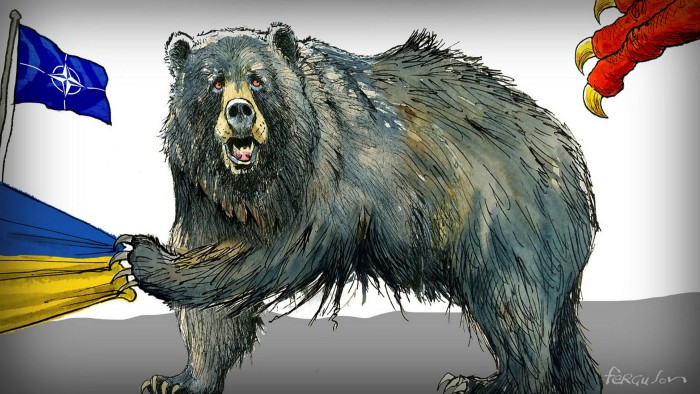Why Vladimir Putin has Ukraine in his sights


Simply sign up to the War in Ukraine myFT Digest -- delivered directly to your inbox.
When Vladimir Putin talks about Ukraine, he sounds like a spurned, abusive husband. A 5,000-word essay that the Russian president published in July, entitled “On the historical unity of Russians and Ukrainians”, is full of protestations of undying love for Ukrainians — combined with threats of violence if the love is not reciprocated. Ukrainians are variously portrayed as the blood brothers of Russians and as neo-Nazis.
Volodymyr Zelensky, the president of Ukraine, joked that Putin must have a lot of time on his hands, to be able to write such a long article. But the contents of Putin’s essay look increasingly alarming when read alongside obvious preparations in Moscow for an invasion of Ukraine. There are now close to 90,000 Russian troops, as well as tanks and artillery, deployed near the Ukrainian border. Last week, Putin made a threatening speech, warning the west not to cross Russia’s “red lines”.
Biden administration officials are briefing that Russia is planning an invasion of Ukraine “as soon as early 2022”. Policymakers in Washington and London fear that these war plans show there is genuine aggressive intent in the Kremlin and that it comes from the top.
Searching for the sources of Russian conduct, western officials point to Putin’s July opus, which is regarded as an authentic expression of his deeply-held views. In it he emphasises the ties of history, language, ethnicity and religion that link Russia and Ukraine. He points out that these ties long predate the Soviet Union. Indeed Putin, who is often accused of nostalgia for the USSR, condemns Soviet leaders who set a “most dangerous time bomb” under the ties between Russia and Ukraine — by granting any part of the USSR the right to secede from the union. “Russia was robbed, indeed,” the president fumes.
Putin insists that Ukraine is a failed state being led astray by scheming foreigners. This is where his argument takes a truly alarming turn. The west, he suggests, is playing a “dangerous geopolitical game” and is intent on using Ukraine as a “springboard against Russia”. This argument could clearly be used to portray a Russian invasion of Ukraine as defensive in nature.
To avert a conflict, the Russians are demanding an explicit guarantee that Ukraine will never join Nato. That demand is likely to be central to the conversation between Putin and Joe Biden, scheduled for this week.
Moscow’s demand sounds like something Washington might consider. The reality is that Ukraine is a long way from joining Nato anyway. Making that reality explicit may not seem like such a momentous concession — particularly if it can avert a conflict.
But there are two reasons why the US and its Nato allies will be very reluctant to make that deal. The first is a matter of principle: Ukraine is a sovereign nation. It should be able to make its own choices without great powers making deals over the country’s head.
The second reservation is prudential. Would giving Russia what it wants really end the possibility of a war? The logic of Putin’s love-hate letter is that the very independence of Ukraine is an abomination — a historical anomaly that has to be reversed. Make a concession now and Putin might move on to the next demand. Russia has already annexed Crimea, part of Ukraine, in 2014, and also demands a veto over aspects of its domestic policies.
Putin’s fury about Ukraine seems to be about more than acknowledging a Russian “sphere of influence”. The contrast with his relatively relaxed attitude to Kazakhstan is instructive. Like Ukraine, Kazakhstan was part of the Russian empire and then the Soviet Union, before becoming an independent state.
Putin has attempted to rebuild Moscow’s influence in Central Asia through the formation of a Eurasian Economic Union, including Kazakhstan. But Moscow’s ambitions have run straight into those of Beijing. In 2013, Xi Jinping, the Chinese president, announced China’s “Belt and Road Initiative” in Astana, the Kazakh capital. Kazakhstan now trades much more with China than Russia. Although some in Putin’s United Russia party still assert a territorial claim on northern Kazakhstan, the fact that this former Soviet republic is slipping out of Moscow’s zone of influence has not met with much resistance from the Kremlin.
The Russians would argue that the difference is that Kazakhstan has not cultivated defence ties with China. But the growing closeness between Astana and Beijing has clear security implications.
The real difference between Kazakhstan and Ukraine may be that Kazakhstan shows no sign of becoming a democracy. Ukraine, by contrast, has consistently resisted efforts to set up an authoritarian regime of the type that Putin has installed in Russia. The Ukrainian system is corrupt and dysfunctional in many ways. But the country has elections that are not a foregone conclusion, and a vibrant civil society.
As Putin accurately observes, Ukraine and Russia are closely linked by history and culture. So the fact that Ukraine has taken a different political path from Russia raises awkward questions for the Kremlin — which likes to argue that “western liberalism” is completely unsuited to Russia. Perhaps that is the real reason why Ukraine excites such fury in Putin. Containing that fury, through the threat of massive economic sanctions, is suddenly the most urgent challenge facing the western alliance.
Letters in response to this column:
Belgium’s model can be part of a Ukraine solution / From Corrado Pirzio-Biroli, Brussels, Belgium
Putin’s policy of dominating the ‘near abroad’ owes a lot to oil / From Daniel Gros, Distinguished Fellow, Centre for European Policy Studies, Brussels, Belgium
West erred by failing to accommodate cold war foe / From Randhir Singh Bains, London IG2, UK
History shows disputes on two fronts risk disaster / From Clive Bellingham, Zurich, Switzerland
Comments